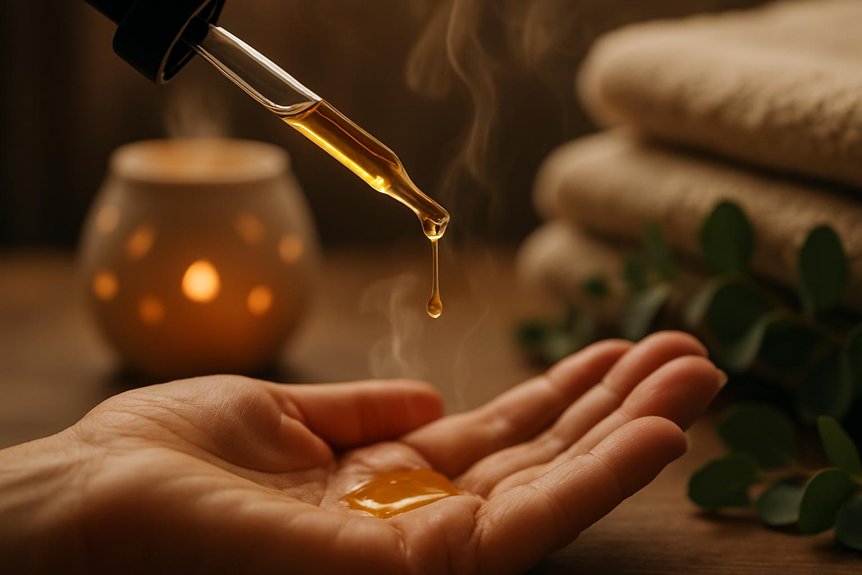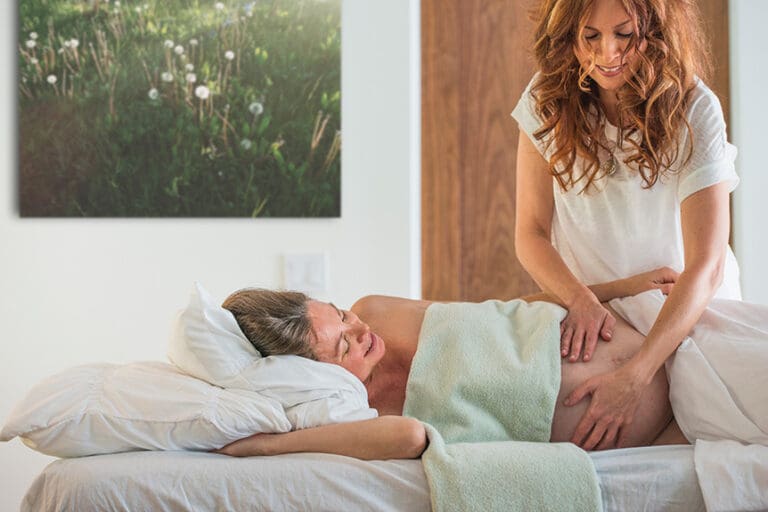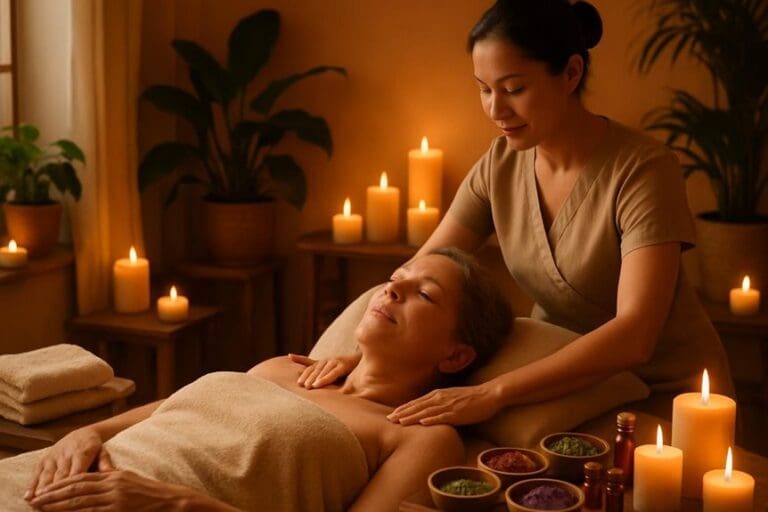In professional aromatic massage, oils are gently warmed to about 38–42°C—slightly above body temperature—for comfort, smooth glide, and muscle ease. Therapists verify with digital thermometers and wrist tests, avoiding hotspots and never exceeding 43–45°C to prevent burns. Cooler (37–39°C) blends are used for delicate areas, pregnancy, or sensitive skin. Heating methods include thermostatic warmers or water-baths; microwaves are avoided. Client feedback guides adjustments, since hydration, circulation, and ambient room warmth affect sensation. Further details explain tailoring and safety controls.
Understanding Temperature in Essential Massage Oils
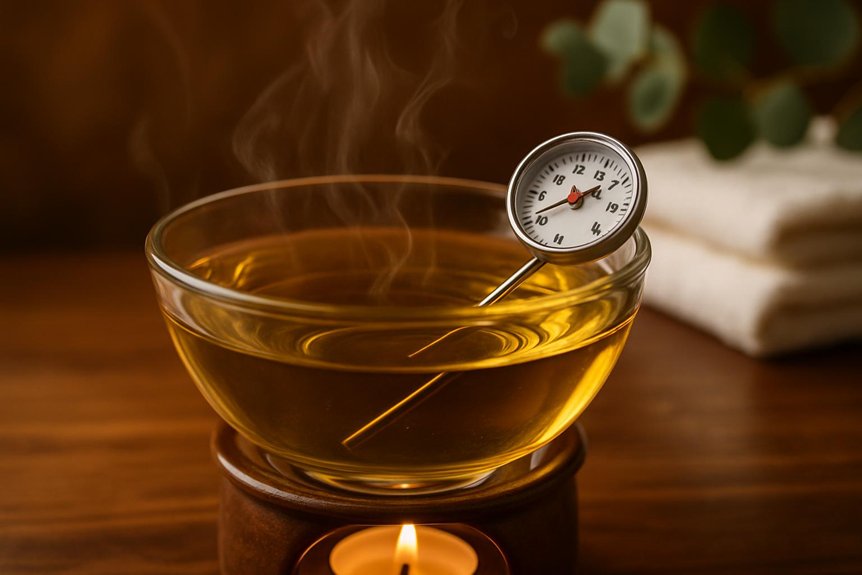
Although often overlooked, oil temperature is a critical variable in aromatherapy massage that influences comfort, tissue response, and essential oil stability. From Spa & Massage’s perspective, temperature guides how touch lands on the body: slightly warmed carrier oils can ease initial glide, soften superficial tension, and invite relaxation, while cooler oils may heighten awareness and reduce flushing in sensitive skin.
Their therapists consider circulation, skin sensitivity, and the volatility of essential oils when preparing blends, aiming to preserve aromatic integrity and client comfort.
In practice, Spa & Massage teams pre-warm carriers gently, test on the inner wrist, and adjust for each client’s preferences, medical history, and moment-to-moment feedback. This attentive calibration supports intimacy with safety—consistent, soothing warmth without hotspots—so the nervous system can settle and the breath deepen. Aromatic massage is often used as a way to relax and heal through the combined effects of carefully selected oils and skillful touch.
What “Warm” Really Means: Safe Ranges in Degrees Celsius
“Warm” for aromatherapy oils typically means 37–40°C—close to skin temperature—providing comfort without risking irritation or burns. In our Spa & Massage clinics, therapists confirm this range with a clean digital thermometer and a wrist patch test.
This ensures the oil feels pleasantly warm rather than hot. Clients are advised to watch for safety signs—any sting, redness, or lingering heat indicates the oil is too hot and should be cooled immediately.
Ideal Oil Temperature
How warm should aromatherapy oil be to feel comforting yet safe on skin? Evidence and clinical practice align around 38–42°C as the ideal range—close to body temperature, gently above it, never hot.
Within this window, viscosity improves, glide is silky, and essential oils diffuse without altering their chemistry. Spa & Massage therapists pre-warm carrier oils to approximately 40°C, then adjust within 1–2°C to match individual preference and local skin sensitivity.
Above 43–45°C, perceived heat rises sharply, increasing burn risk and diminishing relaxation. Below 36–37°C, oil can feel cool and interrupt soothing flow.
For delicate areas or pregnancy massage, our therapists favour 37–39°C. For deep tissue, 40–42°C enhances muscle comfort.
This precise warmth supports intimacy, consent, and calm—nurturing closeness without overwhelming the senses.
Safety Checks and Signs
A practical safety check anchors every aromatherapy session at Spa & Massage: oils are pre‑warmed, verified with a calibrated thermometer, and confirmed on the therapist’s inner forearm before touching the client.
“Warm” corresponds to 38–42°C for most adults; above 43–45°C heat can feel sharp and risky, while below 36–37°C it may feel cool and disrupt relaxation.
Clear signs guide adjustments: skin should blush softly, never redden rapidly; warmth should diffuse, not sting. Clients are invited to signal “too hot” or “cooling,” and therapists lower temperature or add carrier oil accordingly.
For pregnancy, neuropathy, fragile skin, or anticoagulant use, our therapists favour 37–39°C and shorter warm compress priming.
In London clinics, ambient room warmth, towel layering, and continuous feedback keep touch comfortable, intimate, and safe.
How We Warm Oils Safely in Our London Clinics
In Spa & Massage clinics across London, oils are warmed using controlled methods such as thermostatically regulated warmers and water-bath setups to prevent hotspots.
Therapists maintain oils within the safe range established earlier (typically 37–40°C), adjusting for client preference and clinical considerations.
Before application, they follow a strict testing protocol—using a calibrated thermometer and wrist/forearm skin check—to make certain of comfort and avoid thermal irritation.
Controlled Warming Methods
Because consistent warmth enhances comfort without risking skin irritation, Spa & Massage employs controlled, contact-safe methods to heat aromatherapy oils across its London clinics.
Therapists use thermostatically regulated electric warmers with sealed reservoirs, ensuring even heat distribution and preventing hot spots.
Food-grade, shatter-resistant bottles are prechecked, then placed in the warmer only after dilution to the intended blend.
Temperature is verified with a calibrated infrared thermometer before every application, and oils are swirled to equalize warmth.
For clients with sensitive skin or circulatory concerns, therapists pre-warm palms and apply a small test glide at the wrist to confirm comfort.
Bottles are never microwaved or left on radiators.
Warmers are cleaned between clients, and oils are prepared in small, fresh batches to preserve aroma, purity, and intimacy.
Safe Temperature Range
Warmth is calibrated to feel soothing while protecting skin integrity, typically holding blended aromatherapy oils between 38–42°C (100–108°F). This range supports comfort, maintains viscosity for smooth gliding, and reduces risk of irritation, particularly on sensitive areas.
In Spa & Massage clinics across London, oils are warmed gently and held at a stable set point to avoid hot spots. The chosen range respects essential oil volatility, helping preserve aroma and therapeutic properties without overstimulation.
A slightly lower band (36–38°C) is used for heat‑sensitivity, pregnancy care, or fragile skin. Higher temperatures are avoided; above 42°C, burn risk rises and aromatic compounds can degrade.
Therapists adjust warmth to client preference, medical history, and room climate, ensuring touch feels intimate, steady, and secure throughout the session.
Therapist Testing Protocols
A defined protocol guides how therapists at Spa & Massage warm and verify aromatherapy oils before every treatment. Oils are placed in thermostatically controlled warmers, set to the clinic’s safe range, then logged.
Before contact, a therapist performs a triple-check: thermometer reading, wrist test, and inner-forearm glide to confirm comfort and absence of sting or redness.
If temperature exceeds the target, oils are cooled in a sterile bain-marie and rechecked; if too cool, they are incrementally reheated. Viscosity and aroma are assessed to ensure blends remain stable.
For pregnancy, elderly skin, neuropathy, or recent sun exposure, the lower end of the range is used.
Therapists invite clients to confirm warmth at the shoulder or lower back, aligning touch with individual sensitivity and consent.
Factors That Influence Perceived Heat on the Skin
Although massage oil may be poured at a consistent temperature, perceived heat on the skin varies due to several interacting factors. Skin hydration and blood flow are primary: well-hydrated, well-perfused skin feels warmer as heat dissipates more slowly. Thinner or highly sensitive skin—neck, inner arms, abdomen—registers warmth more quickly. Ambient room temperature, humidity, and the warmth of the therapist’s hands also shift sensation.
Glide speed matters: slow strokes allow more contact time and a deeper melt; faster strokes feel cooler. At Spa & Massage, therapists adjust oil volume, stroke pace, and towel layering to modulate warmth safely.
Clients’ recent exercise, menstrual cycle, stress levels, and medications influence vasodilation and perception. Clear consent and check-ins guide comfort, with immediate cooling (lighter pressure, cooler towels) if heat feels too intense.
Essential Oils Vs Carrier Oils: Heat Sensitivity and Stability
Understanding why skin can feel warmer during a massage sets the stage for how different oils behave under heat. Essential oils are highly volatile; warmth from hands or towels accelerates evaporation and can intensify aroma, but also increases the risk of skin irritation if concentrations are too high. Carrier oils—such as sweet almond, grapeseed, or fractionated coconut—are stable lipids with higher heat tolerance, dispersing essential oils evenly and moderating sensation.
At Spa & Massage in London, therapists blend essential oils at conservative dilutions (typically 1–2% for most adults, lower for sensitive skin) into room‑temperature carrier oils, then gently warm the mixture only to skin‑neutral levels. This approach preserves aromatic potency, reduces oxidative stress to oils, and maintains a smooth, comforting glide tailored to each client’s needs and preferences.
Skin Safety: Signs the Oil Is Too Hot and What to Do
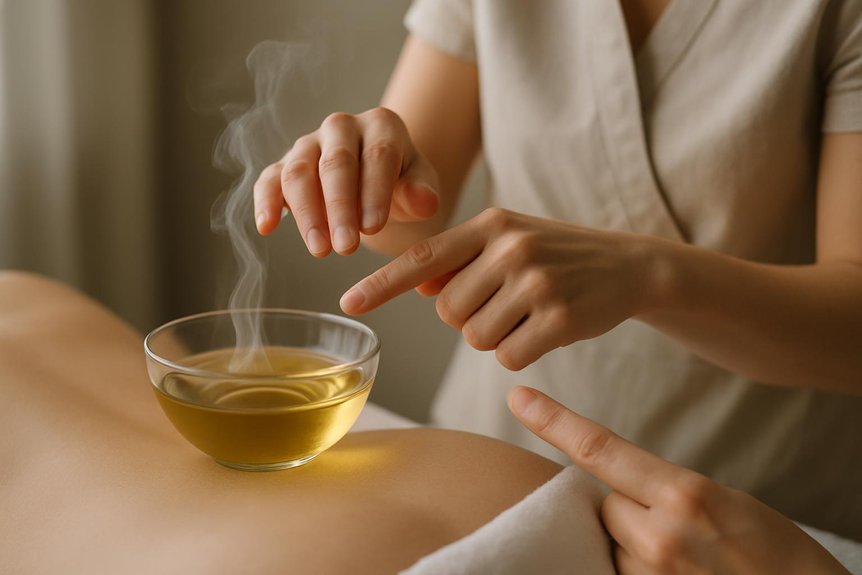
Because heated oils can quickly exceed skin‑neutral temperatures, early recognition of excess heat is essential. Reliable signs include sudden prickling, stinging, or a sharp warmth rather than a gentle melt; pinking that deepens; or lingering heat after the stroke ends. On sensitive areas, a “hot plate” feel signals risk.
If any sign appears, Spa & Massage therapists pause immediately, blot excess oil with a cool, clean towel, and switch to a lower‑temperature blend. They test on the inner wrist before resuming and shorten strokes to limit frictional heat. Clients are invited to speak up at the first hint of discomfort—quiet words are enough.
Aftercare includes cool compresses, fragrance‑free emollients, and monitoring for delayed redness. Any blistering warrants medical advice and postponing future heat exposure.
Tailoring Warmth for Different Body Areas and Client Needs
How warm should massage oil feel on different parts of the body and for different goals? Spa & Massage advises gentle gradients of heat: slightly warmer oil for broad muscles (back, thighs, glutes) to ease guarded tissue, and milder warmth for delicate areas (neck, inner arms, abdomen, feet) to protect sensation.
Evidence suggests warmth enhances comfort, circulation, and receptivity, but perception varies.
Therapists in our London clinics pre-warm oils to a safe range, then fine-tune on contact—testing at the wrist, layering slowly, and checking in.
For stress release, a consistent, cozy warmth supports slow breathing.
For muscle recovery, incremental warmth paired with deeper strokes can soften tone.
Clients seeking tender connection often prefer a caress of warmth, never hot—inviting relaxation without overwhelm.
Considerations for Pregnancy, Sensitive Skin, and Medical Conditions
While warmth can enhance comfort and tissue receptivity, specific groups require tighter safety parameters. During pregnancy, gentle warmth only is appropriate; oils should feel neutral-to-warm, never hot, and essential oils are selected conservatively.
For sensitive or reactive skin, patch tests and carrier-rich blends reduce risk; mild, steady temperatures protect the barrier and minimise flushing.
For cardiovascular, neuropathic, endocrine, or dermatologic conditions, lower temperatures and slower pacing support safety, with careful monitoring of sensation and colour.
At Spa & Massage, therapists review health histories, avoid heated oils over areas with reduced sensation, inflammation, varicosities, or recent injury, and adjust warmth for medication effects (e.g., anticoagulants, steroids).
Communication is invited throughout. If any prickling, dizziness, or excessive warmth arises, temperature is reduced immediately and techniques are modified.
Aftercare: Cooling, Hydration, and Post-Massage Skin Comfort
After a warm aromatherapy session, aftercare focuses on restoring thermal balance, rehydrating tissues, and protecting the skin barrier. In Spa & Massage clinics, therapists guide clients to cool gradually: a tepid rinse or a cool, damp compress over pulse points reduces residual heat without triggering chills.
Hydration is prioritised; they recommend 300–500 ml of water within an hour, then steady sipping to support microcirculation and lymphatic clearance.
For skin comfort, therapists gently blot excess oil and suggest leaving a light film on for two to four hours to enhance barrier recovery. If sensitivity appears, they advise rinsing and applying a fragrance-free occlusive.
Clients are counselled to avoid hot showers, saunas, alcohol, and strenuous exercise for 6–8 hours. Any persistent redness, dizziness, or itching warrants follow-up with the clinic.
Conclusion
In the end, the right oil warmth is less a blaze than a sunrise—gentle, measured, and reassuring. Evidence favors skin-comfort temperatures, careful dilution, and patch testing, with therapists calibrating heat like clinicians tuning an instrument. By reading the skin’s cues, adjusting for pregnancy and sensitivities, and prioritizing circulation without irritation, they keep safety at the helm. Clients can choose warmer or cooler nuances, confident that the science guides the touch and the temperature serves the therapy, not the other way around.
